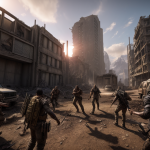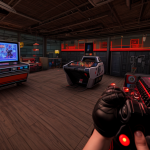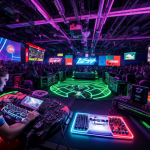Welcome to the thrilling world of racing games! If you’re a fan of fast cars, adrenaline-pumping action, and heart-stopping moments, then you’re in for a treat. But have you ever wondered how racing games work? From the mechanics of the game to the technology behind it, there’s a lot to explore. In this article, we’ll take a deep dive into the world of racing games and discover how they bring the excitement to your screen. Get ready to rev your engines and take off on an exhilarating journey!
Racing games are video games that simulate real-life racing events, such as car races or motorcycle races. They are designed to provide players with an immersive and thrilling experience, as they compete against other virtual drivers or the game’s artificial intelligence. The goal of the game is usually to finish first, by navigating through a variety of tracks and environments, while avoiding obstacles and overtaking other vehicles. Racing games can be played on various platforms, including consoles, PCs, and mobile devices, and they often feature realistic graphics, sound effects, and physics engines to enhance the gaming experience.
Understanding the Basics of Racing Games
The Physics of Racing Games
The Importance of Physics in Racing Games
In racing games, physics plays a crucial role in determining the realism and accuracy of the game’s environment and vehicles. It helps to simulate the behavior of cars and other vehicles, taking into account factors such as weight, momentum, friction, and aerodynamics. Realistic physics in racing games can make the gameplay experience more immersive and enjoyable for players.
How Physics Affects Gameplay
Physics affects gameplay in several ways. For example, in a racing game with realistic physics, players must take into account factors such as weight distribution, tire grip, and aerodynamics when driving. Players must also consider the effects of weather conditions, such as rain and wind, on their vehicle’s handling. Realistic physics can make the gameplay experience more challenging and rewarding for skilled players.
Realistic vs. Arcade-Style Physics
Racing games can have either realistic or arcade-style physics. Realistic physics simulate the behavior of vehicles in a more accurate and detailed manner, while arcade-style physics are more simplified and focus on fun and accessible gameplay. Arcade-style physics may include features such as exaggerated collisions and faster speeds, which can make the game more enjoyable for casual players. The choice of physics style in a racing game depends on the intended audience and gameplay experience.
The Art of Racing Games
The visuals in racing games play a crucial role in immersing players in the game world and enhancing their overall experience. The art of racing games encompasses various aspects, including graphics, realism, and stylization. In this section, we will delve into the role of graphics in racing games and their impact on gameplay.
The Role of Graphics in Racing Games
Graphics refer to the visual representation of the game environment, cars, and other elements. In racing games, graphics are used to create a realistic or stylized representation of the game world, depending on the game’s design and target audience. The graphics are typically created using 3D modeling software and are rendered in real-time during gameplay.
Realistic vs. Stylized Graphics
Racing games can have either realistic or stylized graphics. Realistic graphics aim to replicate the look and feel of real-world racing environments, cars, and tracks. These graphics are typically more detailed and require a higher-end graphics card to run smoothly. Stylized graphics, on the other hand, are more abstract and often feature exaggerated features such as exaggerated car designs and vibrant colors.
The Impact of Graphics on Gameplay
The graphics in racing games can significantly impact the overall gameplay experience. Realistic graphics can provide a more immersive experience, making the game feel more lifelike and engaging. They can also make it easier for players to identify and distinguish between different elements in the game world, such as other cars and track obstacles. However, realistic graphics can also be demanding on hardware, requiring a higher-end graphics card and potentially leading to performance issues on lower-end systems.
Stylized graphics, on the other hand, can provide a more arcade-like experience, with a focus on fast-paced gameplay and over-the-top visuals. They can also be less demanding on hardware, making the game more accessible to a wider range of players. However, stylized graphics may not be as immersive or realistic as realistic graphics, which can impact the overall sense of immersion in the game world.
In conclusion, the art of racing games plays a crucial role in enhancing the overall gameplay experience. Graphics are a key aspect of the art, providing visual representation of the game world and its elements. Whether realistic or stylized, graphics can significantly impact the gameplay experience, from immersion to hardware requirements.
The Controls of Racing Games
In racing games, controls are the set of instructions that allow players to navigate their vehicles and interact with the game environment. There are different types of controls that are used in racing games, each with its own advantages and disadvantages.
Different types of controls
- Keyboard controls: These are the most basic controls in racing games. Players use the arrow keys or WASD keys to control the direction of their vehicle. This type of control is simple and easy to learn, but it can be difficult to achieve precise movements.
- Gamepad controls: These controls use a game controller to control the direction of the vehicle. Players can use the joystick or directional pad to control the vehicle’s movement. This type of control is more precise than keyboard controls, but it can be more difficult to learn.
- Wheel controls: These controls use a steering wheel to control the direction of the vehicle. This type of control is the most realistic and immersive, but it can be expensive and difficult to set up.
The importance of responsive controls
Having responsive controls is crucial in racing games, as it allows players to quickly and accurately maneuver their vehicles. A delay in controls can result in the player losing control of their vehicle, causing them to crash or lose time. Responsive controls can also enhance the overall gameplay experience, making it more enjoyable and satisfying.
How controls affect gameplay
The type of controls used in racing games can significantly affect the gameplay experience. For example, keyboard controls may be more suitable for casual players who are not as familiar with racing games, while wheel controls may be more suitable for experienced players who want a more realistic experience. Additionally, the responsiveness of controls can affect the player’s ability to navigate their vehicle, which can impact their overall performance in the game.
The Mechanics of Racing Games
Game Engines and Development
Game engines play a crucial role in the development of racing games. They provide the foundation for creating the visual and interactive aspects of the game. There are several game engines available, each with its own set of features and capabilities. Some of the most popular game engines for racing games include Unreal Engine, Unity, and the Frostbite Engine.
Unreal Engine is a popular game engine developed by Epic Games. It is known for its ability to create highly realistic graphics and smooth gameplay. This engine has been used to develop several popular racing games, including the Need for Speed series and the Forza Motorsport series.
Unity is another widely used game engine that is known for its flexibility and ease of use. It has been used to develop a variety of racing games, including the popular mobile game, Asphalt 9: Legends.
The Frostbite Engine is a game engine developed by Electronic Arts. It is known for its advanced physics engine and realistic graphics. This engine has been used to develop several popular racing games, including the Need for Speed franchise and the Real Racing series.
The development process of racing games typically involves several stages. First, the game concept is created, followed by the design and planning stages. The game is then prototyped and tested, and any necessary adjustments are made. Finally, the game is polished and prepared for release.
The development of racing games requires a team of skilled professionals, including game designers, programmers, artists, and sound engineers. These individuals work together to create a cohesive and engaging gaming experience.
In addition to the game engine, other software tools are also used in the development of racing games. These tools include level editors, animation software, and physics engines.
Overall, the game engine plays a critical role in the development of racing games. It provides the foundation for creating the visual and interactive aspects of the game, and it allows developers to create highly realistic and engaging gaming experiences.
The Importance of Physics Engines
In racing games, the physics engine plays a crucial role in simulating the realistic behavior of vehicles and their environment. It is responsible for calculating the physical interactions between the car, the track, and other objects in the game world.
A good physics engine should be able to accurately simulate the following aspects of racing:
- Vehicle dynamics: This includes factors such as weight distribution, friction, and suspension travel, which affect how a car handles on different surfaces.
- Tire physics: The physics engine should take into account the behavior of tires, including their grip on different surfaces, wear and tear, and the effects of temperature and pressure.
- Collision detection: The engine must be able to accurately detect and respond to collisions between vehicles and other objects in the game world, such as barriers or obstacles.
- Aerodynamics: The physics engine should take into account the effects of air resistance and drag on the car, which can significantly impact its performance at high speeds.
By simulating these physical interactions accurately, the physics engine can create a realistic and engaging racing experience for players. It also allows for a wide range of gameplay mechanics, such as drifting, drafting, and tactical decision-making, that add depth and challenge to the game.
In addition to improving the realism of the game, a good physics engine can also enhance the overall gameplay experience. For example, it can provide players with more accurate feedback on their driving performance, helping them to improve their skills and strategies over time.
Overall, the physics engine is a critical component of racing games, as it sets the foundation for realistic and engaging gameplay. In the next section, we will explore some popular physics engines used in racing games and how they impact gameplay.
The Use of Track Data in Racing Games
The Importance of Accurate Track Data
In racing games, accurate track data plays a crucial role in providing players with a realistic and immersive driving experience. Track data refers to the information about the layout of the racing track, including the location of turns, straightaways, and other track features. By incorporating accurate track data, racing games can simulate the unique characteristics of each track, such as the level of banking in turns, the width of the track, and the positioning of obstacles. This enables players to experience the thrill of driving on real-life tracks and helps to enhance the overall realism of the game.
How Track Data is Used in Racing Games
Track data is used in racing games to create an authentic driving experience that mimics real-life track conditions. The game developers use track data to create a virtual replica of the racing track, complete with its unique features and characteristics. The track data is integrated into the game’s software, and it is used to calculate the behavior of the player’s car as it navigates the track. This includes factors such as speed, acceleration, braking, and cornering, all of which are affected by the layout of the track. By using accurate track data, racing games can provide players with a highly realistic and engaging driving experience that closely mimics the feeling of driving on a real track.
The Impact of Track Data on Gameplay
The use of accurate track data in racing games has a significant impact on the overall gameplay experience. By providing players with a highly realistic representation of the track, the game becomes more immersive and enjoyable. Players can experience the thrill of driving on real-life tracks, and they can develop a deeper understanding of the unique characteristics of each track. This, in turn, allows players to refine their driving skills and improve their performance on the track. Additionally, the use of accurate track data can enhance the competitiveness of the game, as players must navigate the track based on its unique characteristics, which can lead to intense and exciting races. Overall, the use of accurate track data is a critical component of the racing game experience, providing players with a highly realistic and engaging driving experience.
The Role of Artificial Intelligence in Racing Games
The use of AI in racing games
Artificial intelligence (AI) plays a significant role in the development and functionality of racing games. AI algorithms are used to simulate the behavior of non-player characters (NPCs) and the environment, which allows for more realistic and challenging gameplay. AI also enables the creation of dynamic weather conditions, which can affect the handling of the vehicles and the overall race experience.
How AI affects gameplay
The use of AI in racing games enhances the overall gaming experience by making the gameplay more realistic and challenging. AI-powered NPCs behave more like real drivers, making decisions based on their environment and the current race conditions. This adds an element of unpredictability to the game, which keeps players on their toes and adds to the excitement.
AI algorithms also enable the creation of dynamic weather conditions, which can significantly impact the race. For example, heavy rain or snow can affect the handling of the vehicles, making it more difficult for players to control their cars. This adds an extra layer of realism to the game and requires players to adapt their driving styles accordingly.
Examples of AI in racing games
There are several examples of AI in racing games, each with its unique features and capabilities. One example is the “Neural AI” feature in the game “Assetto Corsa,” which uses machine learning algorithms to simulate the behavior of other drivers on the track. This feature allows for more realistic and unpredictable race conditions, making the game more challenging and exciting.
Another example is the “Dynamic Weather” feature in the game “Forza Horizon 4,” which uses AI algorithms to create realistic weather conditions that can impact the race. This feature adds an extra layer of realism to the game and requires players to adapt their driving styles accordingly.
Overall, the use of AI in racing games enhances the overall gaming experience by making the gameplay more realistic and challenging. AI algorithms enable the creation of dynamic weather conditions and simulate the behavior of NPCs, which adds an element of unpredictability to the game and keeps players engaged.
The Use of Sound in Racing Games
The importance of sound in racing games cannot be overstated. Sound plays a crucial role in creating an immersive gaming experience and enhancing the overall gameplay. The engine’s roar, the screech of tires, and the sound of the wind rushing past the car are all crucial elements that help players feel like they are in the driver’s seat.
Moreover, sound in racing games is not just for creating an immersive experience, but it also serves as a crucial gameplay mechanic. For instance, the sound of a car’s engine can indicate the player’s speed, and the sound of a collision can alert the player to an obstacle or opponent.
Examples of sound design in racing games are abundant. For instance, in the popular game “Gran Turismo,” the sound of the engine changes based on the car’s speed and RPM. Similarly, in “Need for Speed,” the sound of the engine is designed to mimic the exhaust note of a real car, providing an authentic experience for players.
Overall, the use of sound in racing games is an essential aspect of the gameplay experience. It enhances the immersion and creates a more realistic and engaging experience for players.
The Importance of Networking in Racing Games
- Networking is a crucial aspect of multiplayer racing games, enabling players to compete against each other in real-time.
- Without networking, multiplayer racing games would not be possible, as players would not be able to interact with each other and the game servers.
- Networking also affects gameplay, as players need to have a stable connection to the game servers to ensure smooth and lag-free gameplay.
- Examples of multiplayer racing games that rely heavily on networking include “Gran Turismo Sport,” “Forza Motorsport 7,” and “Real Racing 3.”
The Impact of VR and AR in Racing Games
Virtual Reality (VR) and Augmented Reality (AR) have revolutionized the gaming industry, and racing games are no exception. These technologies have transformed the way players experience racing games, making them more immersive and realistic. In this section, we will explore the impact of VR and AR in racing games, their effects on gameplay, and examples of VR and AR in racing games.
The use of VR and AR in racing games
VR and AR technologies have been integrated into racing games to enhance the player’s experience by creating a more realistic and immersive environment. VR technology uses a headset to immerse the player in a virtual world, while AR technology overlays digital information onto the real world.
How VR and AR affect gameplay
The integration of VR and AR in racing games has changed the way players experience the game. With VR, players can feel like they are in the driver’s seat, with a 360-degree view of the track and surroundings. This creates a more realistic and immersive experience, as players can feel the thrill of racing and the rush of adrenaline. AR technology, on the other hand, enhances the player’s experience by providing real-time data and information, such as lap times and speed, without obstructing the player’s view of the track.
Examples of VR and AR in racing games
There are several examples of VR and AR in racing games, including:
- Project Cars 2: This racing game utilizes VR technology to provide players with a realistic and immersive experience. Players can feel like they are in the driver’s seat, with a 360-degree view of the track and surroundings.
- Gran Turismo Sport: This racing game uses AR technology to enhance the player’s experience by providing real-time data and information, such as lap times and speed, without obstructing the player’s view of the track.
- Forza Motorsport 7: This racing game incorporates both VR and AR technology to provide players with a more realistic and immersive experience. Players can feel like they are in the driver’s seat, with a 360-degree view of the track and surroundings, while also receiving real-time data and information, such as lap times and speed, through AR technology.
In conclusion, the integration of VR and AR technology in racing games has transformed the way players experience the game, making it more immersive and realistic. With VR and AR, players can feel like they are in the driver’s seat, with a 360-degree view of the track and surroundings, and receive real-time data and information to enhance their experience. Examples of VR and AR in racing games include Project Cars 2, Gran Turismo Sport, and Forza Motorsport 7.
The Role of Microtransactions in Racing Games
Microtransactions have become a ubiquitous presence in the world of gaming, and racing games are no exception. These small purchases can range from cosmetic upgrades to game-changing power-ups, and they can have a significant impact on the overall experience of the game. In this section, we will explore the role of microtransactions in racing games and how they affect the gameplay.
- The use of microtransactions in racing games
Microtransactions are often used in racing games to give players the ability to purchase additional content or upgrades for their cars. This can include things like new paint jobs, decals, or performance upgrades that can give players an edge on the track. In some cases, these microtransactions are purely cosmetic, while in others they can have a significant impact on the performance of the car.
- How microtransactions affect gameplay
The use of microtransactions in racing games can have a significant impact on the gameplay experience. Players who are willing to spend money on microtransactions can often gain an advantage over those who do not, as they have access to better cars, upgrades, and cosmetic options. This can create a divide between players who have spent money on the game and those who have not, which can lead to frustration and disappointment for some players.
In addition to affecting the gameplay experience, microtransactions can also impact the overall economy of the game. If players are able to purchase powerful upgrades or cosmetic items with real money, it can create an imbalance in the in-game economy, as players who do not spend money may struggle to compete with those who do.
- Examples of microtransactions in racing games
There are many examples of microtransactions in racing games, ranging from small cosmetic upgrades to significant performance boosts. For example, in the popular racing game “Need for Speed,” players can purchase new cars, performance upgrades, and cosmetic items using real money. In “Gran Turismo,” players can purchase in-game currency with real money, which can then be used to purchase new cars and upgrades.
Overall, the role of microtransactions in racing games is a complex issue that can have a significant impact on the gameplay experience. While they can provide players with additional options and upgrades, they can also create an imbalance in the in-game economy and lead to frustration among players who are unable or unwilling to spend money on the game.
The Future of Racing Games
Emerging Trends in Racing Games
- The impact of eSports on racing games
- The use of real-world data in racing games
- The rise of mobile racing games
The racing game industry is constantly evolving, and there are several emerging trends that are shaping its future. These trends are expected to have a significant impact on the way racing games are designed, developed, and played.
The impact of eSports on racing games
eSports has been rapidly growing in popularity over the past few years, and racing games are no exception. eSports racing leagues and tournaments are becoming increasingly popular, and game developers are taking notice. Many racing game developers are now designing their games with eSports in mind, incorporating features that make them more suitable for competitive play.
One example of this is the inclusion of online multiplayer modes that allow players to compete against each other in real-time. Developers are also adding more customization options to allow players to personalize their cars and tracks, making the game more appealing to professional gamers.
In addition, game developers are working with eSports organizations to create official racing game leagues and tournaments. This will help to increase the popularity of racing games and attract more players to the genre.
The use of real-world data in racing games
Another emerging trend in racing games is the use of real-world data to make the games more realistic. Many racing games now use data from real-world racing events to create more accurate simulations. This includes data on car performance, track layouts, and weather conditions.
Game developers are also using real-world data to create more realistic AI opponents. By using data on real-world driving techniques, developers can create AI opponents that behave more like real drivers, making the game more challenging and immersive.
This trend is expected to continue, with game developers incorporating more real-world data into their games to create even more realistic simulations.
The rise of mobile racing games
Finally, mobile racing games are becoming increasingly popular. With the rise of smartphones and tablets, many game developers are creating racing games that are optimized for mobile devices.
These games are often designed to be more casual and accessible than traditional racing games, with simpler controls and more pick-up-and-play gameplay. They are also often free-to-play, with in-app purchases available for players who want to enhance their experience.
While mobile racing games may not have the same level of depth and complexity as traditional racing games, they are attracting a new audience of players who are looking for a more casual gaming experience. As mobile devices become more powerful, it is likely that mobile racing games will continue to grow in popularity.
The Future of Racing Game Technology
As technology continues to advance, the future of racing games looks bright. In the coming years, we can expect to see more realistic graphics, more advanced physics engines, and the incorporation of emerging technologies into racing games.
More Realistic Graphics
One of the most exciting developments in the future of racing games is the potential for more realistic graphics. With the advent of new technologies such as ray tracing and real-time rendering, developers can create more realistic and immersive environments for players to race in. This means that players will be able to experience a greater sense of speed and immersion as they race through virtual tracks.
More Advanced Physics Engines
Another area where racing games are likely to see significant improvements in the future is in the use of more advanced physics engines. These engines simulate the physical properties of cars and tracks, making the gameplay more realistic and challenging. As physics engines become more advanced, they will be able to simulate a wider range of conditions, such as weather and track surface wear, which will add even more realism to the game.
Emerging Technologies
Emerging technologies such as virtual reality (VR) and augmented reality (AR) are also likely to have a significant impact on the future of racing games. VR and AR technologies have the potential to create an even more immersive experience for players, allowing them to feel like they are actually in the race. In addition, these technologies can be used to create new types of racing games, such as those that incorporate real-world tracks and cars.
Overall, the future of racing games looks exciting, with new technologies set to revolutionize the way we play and experience these games. As technology continues to advance, we can expect to see more realistic graphics, more advanced physics engines, and the incorporation of emerging technologies such as VR and AR. These developments will make racing games more immersive, challenging, and exciting than ever before.
The Future of Racing Game Communities
- The growth of online racing game communities
- The increasing popularity of online racing game communities
- The rise of eSports and the growth of professional racing game tournaments
- The availability of online platforms for racing game players to connect and compete
- The diversity of online racing game communities
- The emergence of niche communities for specific racing games or genres
- The formation of regional and international communities for players to connect and compete on a larger scale
- The increasing popularity of online racing game communities
- The importance of community in racing games
- The role of community in fostering a sense of belonging and identity for players
- The development of in-game social features and communication tools to facilitate community building
- The role of communities in driving the development and evolution of racing games
- The impact of community on the player experience
- The sharing of tips, strategies, and content by players within the community
- The development of rivalries and friendships within the community
- The role of community in fostering a sense of belonging and identity for players
- The future of racing game competitions and events
- The growth of professional racing game tournaments and leagues
- The increasing prize pools and recognition for top players
- The growth of sponsorships and partnerships between racing game players and brands
- The emergence of new forms of racing game competitions and events
- The integration of virtual reality and augmented reality technologies in racing game competitions
- The exploration of new game modes and formats for racing game competitions, such as team-based or solo competitions
- The potential for racing game competitions to reach a wider audience
- The growth of streaming platforms and online content creation as a means for players to showcase their skills and share their experiences with a wider audience
- The potential for racing game competitions to become a mainstream form of entertainment and a source of revenue for the gaming industry.
- The growth of professional racing game tournaments and leagues
The Future of Racing Game Development
- Advancements in technology
- The impact of virtual reality (VR) on racing games
- The potential for realistic physics simulations
- The role of artificial intelligence (AI) in enhancing gameplay
- The evolving gaming landscape
- The rise of mobile gaming and its impact on racing games
- The influence of eSports on racing game development
- The increasing demand for cross-platform compatibility
- Embracing new trends and genres
- The popularity of battle royale games and their influence on racing games
- The potential for racing games to incorporate elements of other genres, such as role-playing games (RPGs) or simulation games
- The role of player feedback and community input in shaping the future of racing game development
- The importance of staying relevant and competitive
- The challenge of keeping up with advancements in technology and gaming trends
- The need for ongoing updates and improvements to maintain player engagement
- The role of collaboration and partnerships in driving innovation in racing game development
The Future of Racing Game Regulation
- The potential for increased regulation of racing games
The future of racing game regulation is likely to see an increase in the number of laws and regulations that govern the industry. This could be due to concerns over the potential harm that racing games may cause, such as aggression and violence. These concerns may lead to increased pressure on governments to introduce laws and regulations that limit the content and themes of racing games.
- The impact of regulation on gameplay
Regulation of racing games may also impact the way that games are designed and played. For example, if laws are introduced that limit the amount of violence and aggression in racing games, game developers may need to change the way that they design their games to comply with these laws. This could lead to a shift towards more realistic and less violent gameplay, or towards games that focus on other aspects of racing, such as strategy and skill.
- The future of racing game ratings and classifications
Rating and classification systems for racing games may also be impacted by increased regulation. Governments may introduce new rating systems or modify existing ones to better reflect the potential harm that racing games may cause. This could lead to more stringent rating requirements for racing games, or to the creation of new categories for games that are deemed to be particularly violent or harmful.
Overall, the future of racing game regulation is likely to be shaped by a range of factors, including concerns over the potential harm that racing games may cause, the impact of technological advancements on game design, and the changing attitudes of consumers towards video games. As the industry continues to evolve, it will be important for game developers, regulators, and consumers to work together to ensure that racing games remain a safe and enjoyable form of entertainment for everyone.
FAQs
1. How do racing games work?
Racing games are video games that simulate real-life racing scenarios. They usually involve controlling a car or other vehicles and competing against other players or computer-controlled opponents. The objective of the game is to finish the race in first place. Racing games can be found on various platforms, including consoles, PCs, and mobile devices.
2. What are the different types of racing games?
There are several types of racing games, including arcade racing games, simulation racing games, and racing simulations. Arcade racing games are designed for casual players and usually have simple controls and exaggerated graphics. Simulation racing games, on the other hand, are designed for more serious players and attempt to simulate real-life racing conditions as closely as possible. Racing simulations are the most realistic type of racing game and are often used for training purposes by professional racers.
3. How are racing games developed?
Racing games are developed using game engines, which are software programs that provide the necessary tools and features for creating games. The game engine includes a graphics engine, physics engine, and other components that are required for creating a functional game. The developers use the game engine to create the game world, including the cars, tracks, and other elements. They also add the necessary code to control the gameplay and implement features such as collision detection and damage modeling.
4. What are the most popular racing games?
Some of the most popular racing games include Gran Turismo, Forza Motorsport, and Need for Speed. These games have gained a large following among racing enthusiasts and are known for their realistic graphics and immersive gameplay. Other popular racing games include Dirt Rally, Assetto Corsa, and Project Cars.
5. How can I improve my racing game skills?
To improve your racing game skills, you should start by practicing regularly. This will help you become familiar with the game mechanics and learn how to control your vehicle effectively. You should also try different racing games to find the one that suits your playing style the best. Additionally, you can watch tutorials and read guides to learn advanced techniques and strategies. Finally, you can compete against other players online to test your skills and learn from your mistakes.









